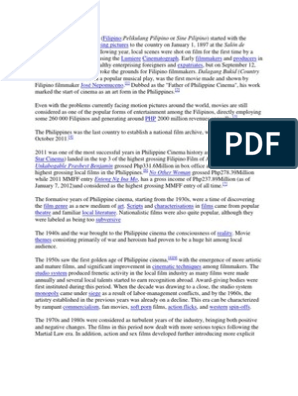0% found this document useful (0 votes)
177 views8 pagesHistory and Development of Film and Television
1) The 1930s-1940s saw the early development of the Philippine film industry, with early films imitating popular theater forms and avoiding questioning the establishment.
2) During World War 2, the Japanese occupation halted much filmmaking but some local filmmakers produced propaganda films for the Japanese. War films became popular after the war.
3) The 1950s were a "Golden Age" for Philippine films, with four major studios producing a variety of films. However, the 1960s saw a decline due to foreign films influencing local productions and focusing more on violence and sex. Labor issues also affected the studios.
Uploaded by
mhillen nicoleCopyright
© © All Rights Reserved
We take content rights seriously. If you suspect this is your content, claim it here.
Available Formats
Download as DOCX, PDF, TXT or read online on Scribd
0% found this document useful (0 votes)
177 views8 pagesHistory and Development of Film and Television
1) The 1930s-1940s saw the early development of the Philippine film industry, with early films imitating popular theater forms and avoiding questioning the establishment.
2) During World War 2, the Japanese occupation halted much filmmaking but some local filmmakers produced propaganda films for the Japanese. War films became popular after the war.
3) The 1950s were a "Golden Age" for Philippine films, with four major studios producing a variety of films. However, the 1960s saw a decline due to foreign films influencing local productions and focusing more on violence and sex. Labor issues also affected the studios.
Uploaded by
mhillen nicoleCopyright
© © All Rights Reserved
We take content rights seriously. If you suspect this is your content, claim it here.
Available Formats
Download as DOCX, PDF, TXT or read online on Scribd
/ 8





















































































